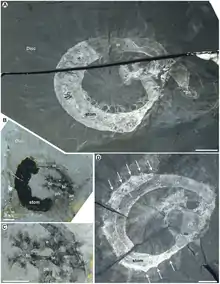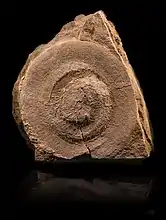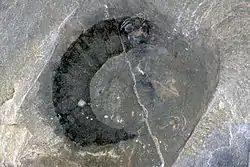Eldonia
Eldonia is an extinct soft-bodied cambroernid animal of unknown affinity,[3] best known from the Fossil Ridge outcrops of the Burgess Shale, particularly in the 'Great Eldonia layer' in the Walcott Quarry.[4] In addition to the 550 collected by Walcott,[5] 224 specimens of Eldonia are known from the Greater Phyllopod bed, where they comprise 0.43% of the community.[6] Species also occur in the Chengjiang biota,[2] and in Upper Ordovician strata of Morocco.
| Eldonia | |
|---|---|
 | |
| Eldonia ludwigii from the middle Cambrian Burgess Shale. | |
| Scientific classification | |
| Kingdom: | Animalia |
| Superphylum: | Deuterostomia |
| Stem group: | Ambulacraria |
| Clade: | †Cambroernida |
| Family: | †Eldoniidae |
| Genus: | †Eldonia |
| Species | |
| |
| Synonyms | |
Walcott's original interpretation as a holothurian was rapidly disputed.[7] Alternative affinities to be suggested, which did not stand the test of time, included the siphonophores[8][9][10] and a coelenterate medusa.[11]
It takes the form of a round, medusoid disk (which originally led to suggestions of a jellyfish affinity)[12] with a C-shaped gut trace. The gut is recalcitrant and can be extracted using Hydrofluoric acid.[13] The organism is frequently found in association with the lobopod Microdictyon, which is presumed to have fed on Eldonia.[14]
The eldoniids form a clade that also includes Paropsonema, Rotadiscus, and Stellostomites.[15]
 Eldonia berbera
Eldonia berbera Eldonia ludwigii, Walcott Quarry. About 4 cm long
Eldonia ludwigii, Walcott Quarry. About 4 cm long
References
- ALESSANDRELLO Anna; A BRACCHI Giacomo (2003). "Eldonia berbera n. sp., a new species of the enigmatic genus Eldonia Walcott, 1911 from the Rawtheyan (Upper Ordovician) of little Atlas (Erfoud, Tafilalt, Morocco)". Atti della Società Italiana di Scienze Naturali e del Museo Civico di Storia Naturale in Milano. Milano, ITALIE. 144 (2): 337–358. ISSN 0037-8844.
- CHEN, J-Y.; M-Y. ZHU; G. Q. ZHOU (1995). "The early Cambrian medusiform metazoan Eldonia from the Chengjiang Lagerstätte" (PDF). Acta Palaeontologica Polonica. 40: 213–244.
- Signor, P. W.; Vermeij, G. J. (1 July 1994). "The Plankton and the Benthos: Origins and Early History of an Evolving Relationship". Paleobiology. 20 (3): 259–406. doi:10.1017/s0094837300012793. ISSN 0094-8373. JSTOR 2401005.
- Gabbott, S. E.; Zalasiewicz, J.; Collins, D. (2008). "Sedimentation of the Phyllopod Bed within the Cambrian Burgess Shale Formation of British Columbia". Journal of the Geological Society. 165 (1): 307–318. Bibcode:2008JGSoc.165..307G. doi:10.1144/0016-76492007-023.
- Durham, J. W. (1974). "Systematic Position of Eldonia ludwigi Walcott". Journal of Paleontology. 48 (4): 750–755. Bibcode:1974JPal...48..524M. JSTOR 1303225.
- Caron, Jean-Bernard; Jackson, Donald A. (October 2006). "Taphonomy of the Greater Phyllopod Bed community, Burgess Shale". PALAIOS. 21 (5): 451–65. doi:10.2110/palo.2003.P05-070R. JSTOR 20173022.
- Clark, H. L. (1912). "Fossil Holothurians" (PDF). Science. 35 (894): 274–278. doi:10.1126/science.35.894.274-a. JSTOR 1638409. PMID 17809248.
- Madsen, F. J. (1957). "On Walcott's Supposed Cambrian Holothurians". Journal of Paleontology. 31 (1): 281–282. Bibcode:1974JPal...48..524M. JSTOR 1300523.
- MADSEN, F. J. (1962). "The systematic position of the Middle Cambrian fossil Eldonia" (PDF). Medd. Dan. Geol. Foren. 15: 87–89.
- MADSEN, F. J. (1956). "Eldonia, a Cambrian Siphonophore-formerly interpreted as a Holoturian[sic]". Videnskabelige Meddelelser Fra Dansk Naturhistorisk Forening I Københaven. 118: 7–14.
- Lemche, Henning (1960). "A possible central place for Stenethecoides Resser, 1939 and Cambridium Horny, 1957 (Mollusca Monoplacophora) in invertebrate phylogeny". Rep. Int. Geol. Congr. XXI Session, Norden (Pt. 22): 92–101.
- Jun-yuan, C.; Mao-yan, Z.; Gui-qing, Z.; Signogneau-russell, D.; Hahn, R.; Koz{l}owska-dawidziuk, A.; Stefaniak, K. (1995), "The Early Cambrian medusiform metazoan Eldonia from the Chenjiang Lagerstätte" (PDF), Acta Palaeontologica Polonica, 40 (3): 213–244, retrieved 2009-08-12
- Butterfield, N. J. (1 July 1990). "Organic Preservation of Non-Mineralizing Organisms and the Taphonomy of the Burgess Shale". Paleobiology. 16 (3): 247–399. doi:10.1017/s0094837300009994. ISSN 0094-8373. JSTOR 2400788.
- Zhang, X-G; Hou, X-G (Dec 2007). "Gravitational Constraints on the Burial of Chengjiang Fossils". PALAIOS (Submitted manuscript). 22 (6): 513–518. Bibcode:2007Palai..22..448Z. doi:10.2110/palo.2006.p06-085r. ISSN 0172-4622.
- Caron, J.; Conway Morris, S.; Shu, D.; Soares, D. (2010). Soares, Daphne (ed.). "Tentaculate fossils from the Cambrian of Canada (British Columbia) and China (Yunnan) interpreted as primitive deuterostomes". PLoS ONE. 5 (3): e9586. Bibcode:2010PLoSO...5.9586C. doi:10.1371/journal.pone.0009586. PMC 2833208. PMID 20221405.
| Wikimedia Commons has media related to Eldonia. |
External links
- "Eldonia ludwigi". Burgess Shale Fossil Gallery. Virtual Museum of Canada. 2011.